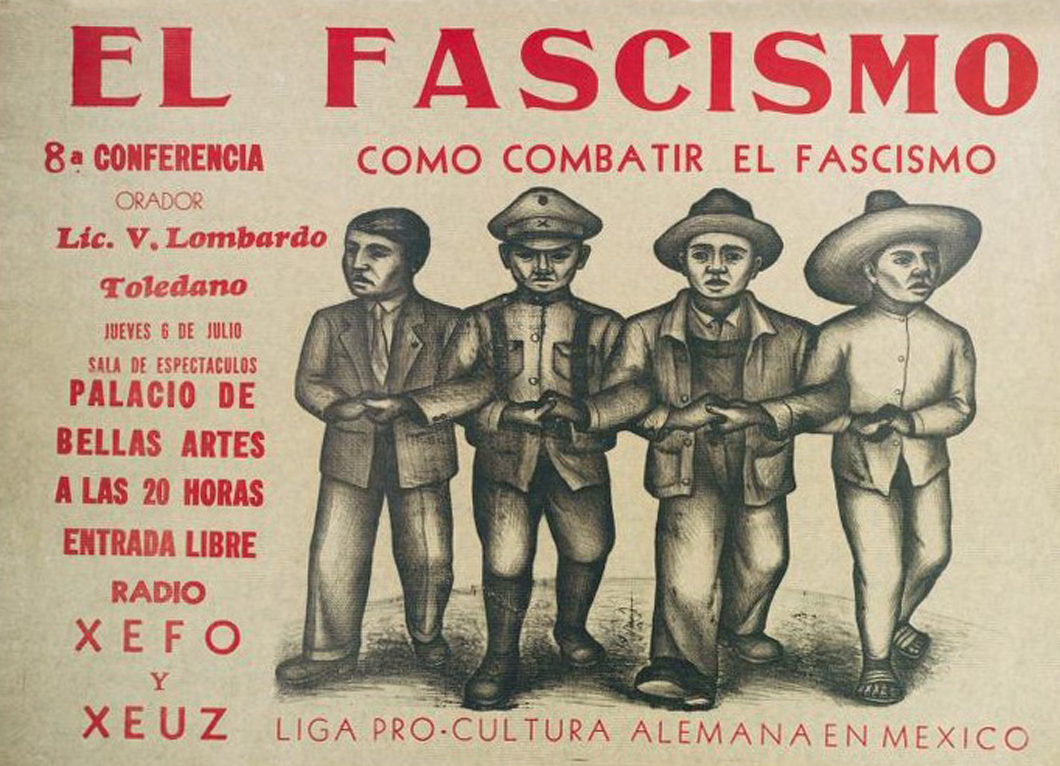
Liga Pro Cultura Alemana was a pro-German culture anti-Nazi organization in Mexico that grew out of the communist Popular Front or People's Front. Editorial Masas was a small communist aligned publisher. Both were started by the same man, Heinrich Gutmann. Both employed Esperanza Lopez Mateos. Heinrich Gutmann founded Editorial Masas in 1937 and Liga Pro Cultura Alemana in early 1938.
Henry Schnautz wrote in a letter in 1941 that Esperanza had been a high level secretary in the Education Ministry for 5 years. The SEP, Secretaria de Educacion Publica, loaned many resources to the LPC, the Liga Pro de Cultura Alemana. If she was the stenographer for the entire Liga Pro German culture series, that is likely when Gutmann hired her to run the Editorial Masas office. Both organizations, Liga Pro and Editorial Masas, used the same post office address. It was on Editorial Masas letterhead that Esperanza first wrote Charles Knopf publisher asking about film rights for Traven novels.
I am heavily indebted to Fritz Pohle for most of the Gutmann information.
Fritz Pohle, "Das Mexikanische Exil," 1986, J.B. Metzlersche Verlagsbuchhandlung
Fritz Pohle, "Otto Rühle in Mexiko", in "Alternative Lateinamerika, Das deutsche Exil in der Zeit des Nationalsozialismus", Karl Kohut, Mühlen, Vervuert Verlag, 1994
Heinrich Gutmann emigrated to Mexico from Germany shortly after the Reichstag fire of February 1933 and the book burnings of May 1933. In Germany he was an editor of a tabloid Tempo for the publishing house Ullstein. He later claimed to be an editor of Vorwärts, which was Traven's early publisher, but Pohle seems to doubt this, or have no independent confirmation. In Mexico he became known for his photos of Mexican life that he published in "Life", "Fortune", and other American magazines.
In 1935 Gutmann joined as photojournalist the organization "League de Escritores y Artistas Revolucionarios" (LEAR). LEAR was at first a communist cultural organization that saw itself closely allied with Russia, but as the decade drew on it became more widely based supporting the program of Cardenas and more diverse politically generally supporting anti-fascism. Gutmann became a principal of the organization. Gutmann developed a relationship with Joseph Freeman , the American communist "New Masses" editor. In 1936 Gutmann organized an exhibition by the German artist Joseph Albers. Otto Ruhle, the German communist, was one of the attendees. At that time Ruhle was an employee of the Ministry of Education, tasked with reforming the schools.
Gutmann became friends with the Undersecretary in the Ministry of Education, Luis Chavez Orozco. This and his other activities brought him to the attention of the Nazi government's official delegation, who reported back to Berlin that Gutmann repeatedly used the Ministry of Education to make trouble for them in the secondary schools, presumably by countering Nazi propaganda.
In 1937 Gutmann founded the publisher, "Editorial Masas". Early that year Gutmann went with Lazaro Cardenas as photo-journalist on one of his travels through the country in support of agrarian reform. Cardenas granted Gutmann and Joseph Freeman an interview in Acapulco (Traven's hometown at that time) on his domestic program and support for the Spanish Republic. Gutmann published this under the title "Lazaro Cardenas - The Country Teacher of Mexico." A few months later Gutmann expanded this and published it under his new Editorial Masas imprint as "Lazaro Cardenas - Visto por tres hombres" ("Cardenas - as seen by three men") a portrait of Cardenas with his own photos and written contributions by Joseph Freeman and Luis Chavez Orozco.
In late 1935 Otto Rühle appeared in Mexico. He had accepted a job with the Cardenas Ministry of Education to develop new programs for the schools. Rühle was a German communist who broke early with the Russian Bolsheviks. He was a founder with Karl Liebknecht, Franz Mehring and Rosa Luxemburg of the German Spartacist League which evolved into the German communist party, the KPD. He was a lifelong Marxist, but never a Stalinist.
The 1934 election of Lazaro Cardenas was Mexico's move to the left.
Pohle, "Das Mexikanische Exil, p. 134, -
"...the educational system and the Ministry of Education itself became the stronghold of the Left under the Cárdenas administration in the following years. It was not only the influence of the most radical politicians from ruling party and trade unions that was decisive here. The Communists, who supported the reform despite initial reservations, were also strongly represented. The new state textbooks were filled with revolutionary pathos, the schools sang the "Internationale" and raised the red flag next to the national flag. Special importance was given to the government's school and literacy program in rural areas. The land teachers were effective propagandists of agrarian reform and an important factor in the organization of peasants. So they became a symbol for the entire reform policy of the regime. It is no coincidence that the German exile Heinrich Gutmann published an interview with the president under the significant title of Lázaro Cárdenas - the country teacher of Mexico. But they also became martyrs to the regime: hundreds of them were murdered in the thirties by clerical fascist gangs and the private militia of the landowners."
But the reforms began in 1934 met resistance and were not always clear directions for implementation. Rühle had studied with psychologist Alfred Adler and had published in 1911 a child psychology text. Rühle began studying the system and within a few months began to suggest reforms. Pohle says the Cardenas government was polarized and weakened by the effort and withdrew the more utopian elements towards the end of the six-year administration. Ruhle was just one element of the entire Education reform and most of his proposals were probably not implemented. Ultimately education is inseparable from labor, and labor was represented by the CTM and the committed Stalinist Vicente Lombardo Toledano. Rühle was a critic of Stalin and the Soviet education system. The powerful Lombardo opposed Rühle's reforms. The subject was put to rest when Rühle publicly sat in judgement on Trotsky's mock trial to counter Stalin's show trials, and publicly signed the finding that Trotsky was innocent of Stalin's verdict in absentia. Rühle left the Ministry of Education in 1938.
Alice-Rühle-Gerstel memoir of Trotsky in Coyoacan during the 1937 Dewey Commision counter-trial Link to "No Verses for Trotsky"
Gutmann hosted Ernst Toller in Mexico for an extended visit in 1937. Toller was best known as a left wing German playwright. For six days in 1919 he was President of the Bavarian Soviet Republic, the failed Munich government which Ret Marut a.k.a. B. Traven supported and caused him to flee to Mexico to avoid execution for treason. Toller was imprisoned for 5 years, released, and later his citizenship revoked, then expelled by the Nazis in 1933. In November 1937 he came to Mexico from his exile in the United States. He gave a lecture at the Palacio de Bellas Artes, the recently completed jewel of Mexican art and performance, on the 20th anniversary of the Russian October Revolution organized by the CTM, Lombardo's labor union. Dignitaries included Lombardo and the Mexican Communist party leader. Toller had been one of the signers of the 1936 Paris call for a German Popular Front, which was the unifying idea pushed by communist parties all over the west that all the German left, in fact all non-Nazis of every country, should ignore their differences, semantic and real, and together under one banner oppose the German Nazi threat. Toller was well known. El Maestro Rural, the magazine of the Ministry of Education, had published a year earlier an excerpt from his autobiography recently published in Spanish. Toller was in Mexico as a guest of LEAR. Toller spent a month in Mexico much of the time touring the country with Gutmann.
Pohle, Das Mexikanische Exil, p.86
Toller: "At the beginning of this year, I'm sitting in Paris at a table with men who once fought passionately, Catholics and Communists, socialists and liberals, trade unionists and freelance writers, men from abroad and, at mortal danger, had come from Germany. They were all united in one and the longed-for goal of creating a Germany of freedom, peace and justice. ...They had united, as we do today, in the German Popular Front."
The German Nazi emissary in Mexico made a statement that Toller was no longer a German and could not speak for Germans.
Toller's visit and speeches apparently motivated an effort by Heinrich Gutmann to attempt to set up an organization in service to the German Popular Front in Mexico. A more modest plan evolved to promote a German Cultural League. In March 1938 a group known as "Liga Pro-Cultura Alemana en Mexico" formed with a non-partisan charter under the management of Heinrich Gutmann. Recognizing the implicit threat of German national emigres recognizing themselves as representing German culture in defiance of Nazi demands, the League published a list of 21 prominent Mexicans who designated themselves as a "comite protector." These were government, union and LEAR members. The first event was a series of lectures starting in April 1938 under the title "La Verdadera Cultura Alemana." The first speaker was Lombardo Toledano who would speak on the true German culture embodied by Johann Goethe. All of the speakers were Mexican.

From the introduction to the first Liga Pro lecture series -
If we, the German-speaking anti-Nazis united in the League Pro-Cultura Alemana en Mexico, put this series of lectures under the title "True German Culture" we do so in the sense of challenging our enemies. We want to show that true German culture - and that means German culture - has nothing in common with that false doctrine, that arrogance and that totalitarian madness. And we want to prove that every true culture is the common good of all peoples, despite their peculiarities and particularities.
The Ministry of Education provided the prestigious Palacio de Bellas Artes for the speeches. The ambassador of the Spanish Republic, which had not fallen yet, sat in attendance.
Alfred Miller wrote for the New York "Deutsche Volksecho" (p91 - Pohle "Exil") -
For the first time, the league made its public appearance on April 23. Dr. Vicente Lombardo Toledano, Mexico's greatest labor leader, spoke about Goethe. The lecture took place at the Palacio de Bellas Artes and was broadcast to the whole country through the government's radio station. - The hall was as crowded as possible only in Mexico. Every standing room, even the hallways were crowded with listeners, and hundreds of people had no way to find room in the hall. Countless Germans, Austrians and Mexicans were present, and the German Nazi legation was represented by five people...
The lectures were presented at weekly intervals. The second was on the German poet and writer Heinrich Heine, who famously said, "Where they burn books, in the end they will also burn people." Other topics were forbidden music and banned authors (burned books), which discussed specific writers in exile such as Nobel winner Thomas Mann. The last topic of the first series was on economics, specifically the German economists, Hegel, Marx and Engels. There were musical performances between speeches and the entire series was broadcast on government radio stations.
On May 17, 1938, the LPC organized a memorial service for Carl von Ossietzky in the Palacio de Bellas Artes. Ossietzky was a German pacificist who received the 1935 Nobel Peace Prize as a prisoner in a German concentration camp and died as a prisoner on 4 May 1938.
Later in 1938 two more lecture series were given that were more political and less cultural. Many of the speakers were significant political figures who held office in the government or were high up in the ruling party or unions. By hosting in the Palacio, and broadcasting on government radio, it gave the definite appearance that the government was promoting the Liga Pro Cultura Alemana. The highlight of all the lecture series, Pohle says, were the talks given by the charismatic Lombardo Toledano.
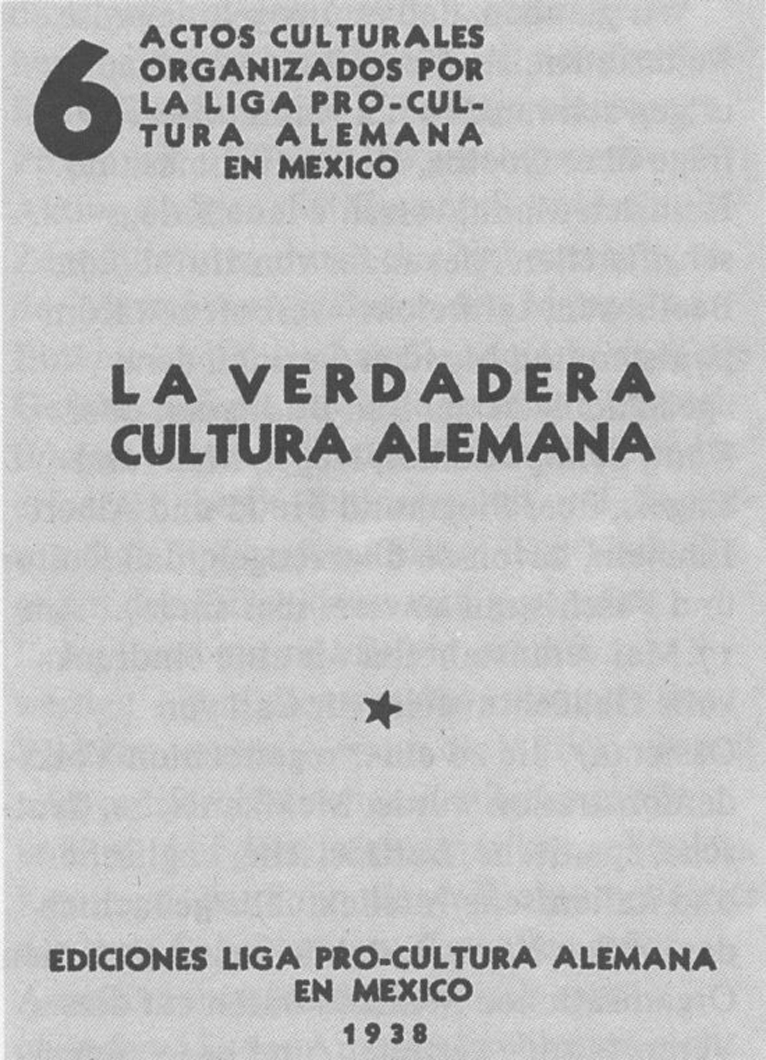
Kießling, Wolfgang, "Brücken nach Mexiko", Dietz Verlag Berlin, 1989, p.243
In the summer of 1938, the league self-published its first publication in 5,000 copies. The brochure "La Verdadera Cultura Alemana" contained more than 100 pages of the texts of the previous cycle of lectures. The stenographic transcriptions were by Esperanza Lopez Mateos.
Kießling is the primary reference that later authors have used to say that Esperanza Lopez Mateos was the stenographer for the first LPC series. Pohle does not have it that I can see. Since Kießling does not credit a source, I assume he is looking at the original 1938 publication and seeing her name credited in print. There are 5 copies of the book in North America shown in WorldCat. This agrees with Gabriel Figueroa's quote.
Poniatowska, Elena, "La Mirada que Limpia, Editorial Diana, 1996 -
Gabriel Figueroa -
(p. 83) I knew the teacher Lombardo Toledano by means of Esperanza, who was his collaborator and she went to all the conferences, meetings and acts that he participated in, to transcribe his speeches. He had a lot of respect for her, because Esperanza was a militant with much confidence, who had worked all her life in the social field. The relationship with her connected me to Lombardo, and he began this way to ask me to participate in the production of several documentaries and movies.
(p. 35) In the mornings she was a secretary ... in the afternoons she made translations. She didn't leave the house. She went to neither dances or dinners. She never went anywhere. She stayed working the whole time. She had a fabulous vitality. She managed a small publisher, Editorial Masas, S.C.L. with her mother, my aunt Elena, in a small house at 30 Donceles.
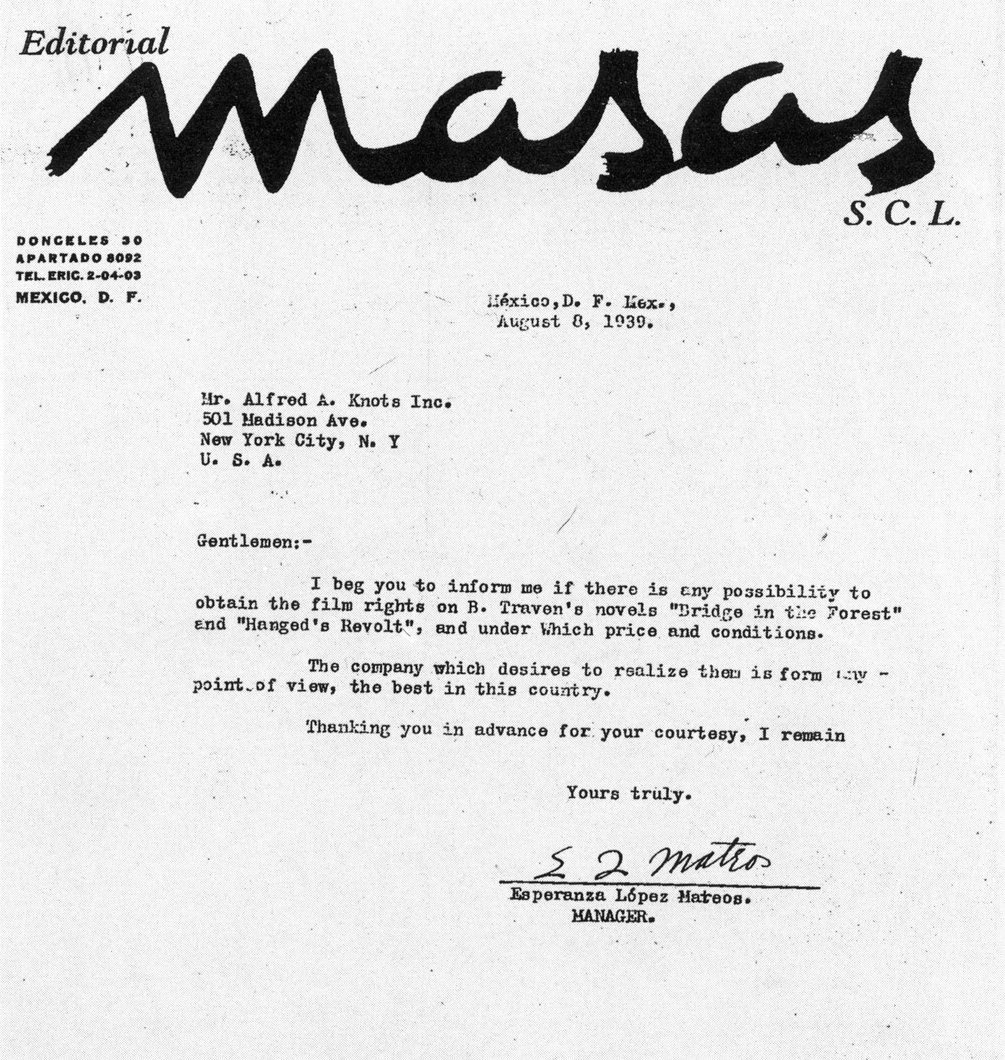
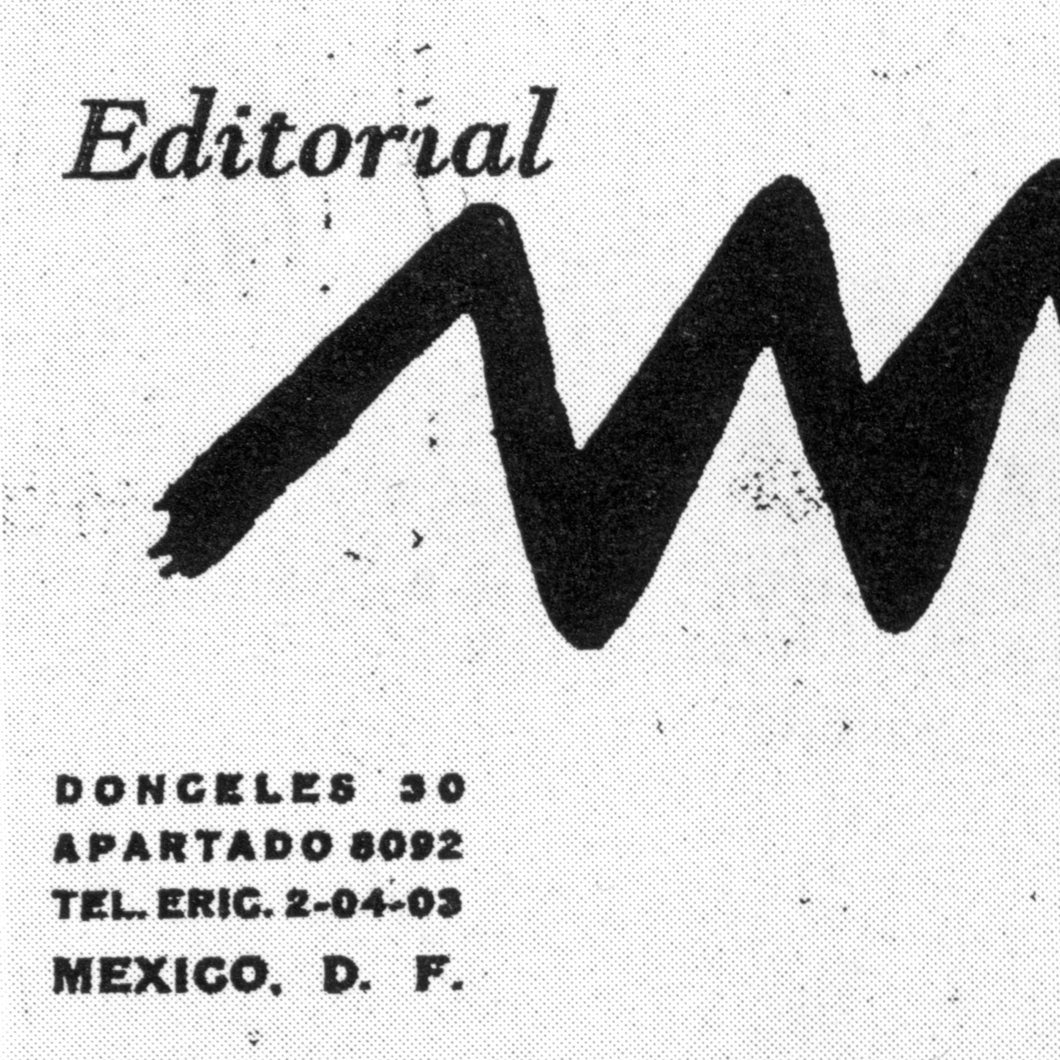
Guthke, Karl, "B. Traven, the Life Behind the Legends", Lawrence Hill, 1991
Guthke has a letter dated August 1939 from Esperanza in his photos section. By all accounts it is allegedly the first contact between Esperanza Lopez Mateos and B. Traven. The books in question are the same ones that Traven will eventually complain have been made into unauthorized Spanish translations in the introduction to his April 1941 edition of "Puente en la Selva," translation by Esperanza. Here Esperanza free translates them into English rather to their actual English titles because she probably has the Spanish pirate versions.
The address -
Donceles 30
Apartado 8092
Mexico, D.F.

The Letterhead on p. 236 of Kießling
In a letter on Liga Pro Cultura Alemana en Mexico letterhead, just a few days after the La Verdadera lectures begin, April 30, 1938, addressed to Lombardo Toledano, the address is Apartado 8092. Apartado is post office box. 8092 is the address for both Liga Pro Cultura Alemana and Editorial Masas.
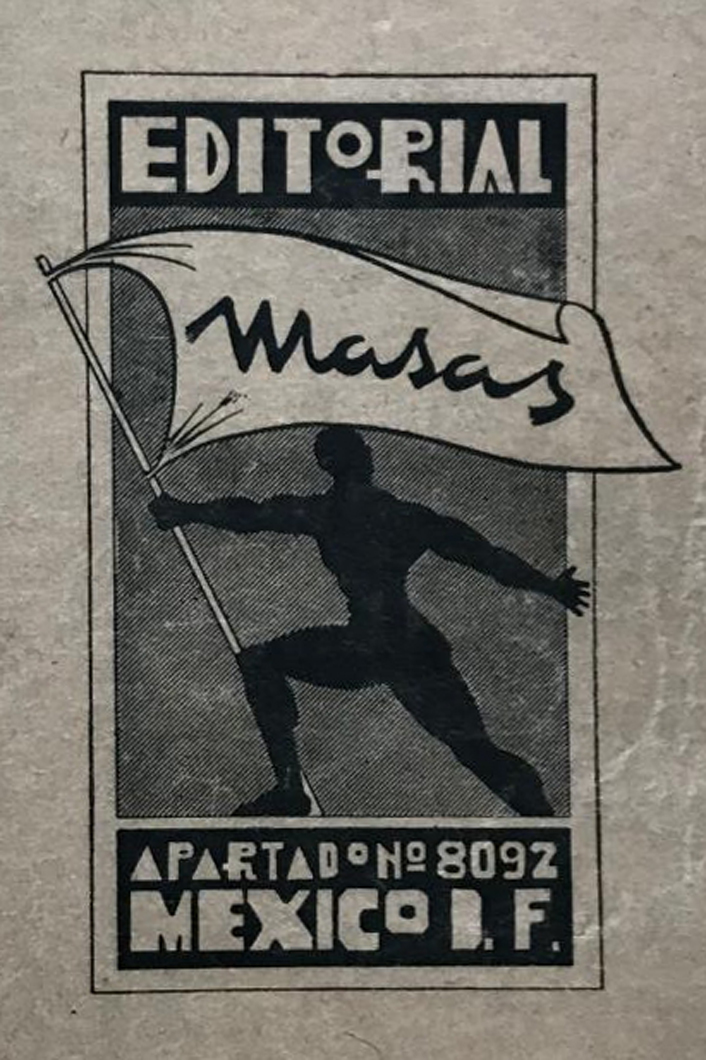
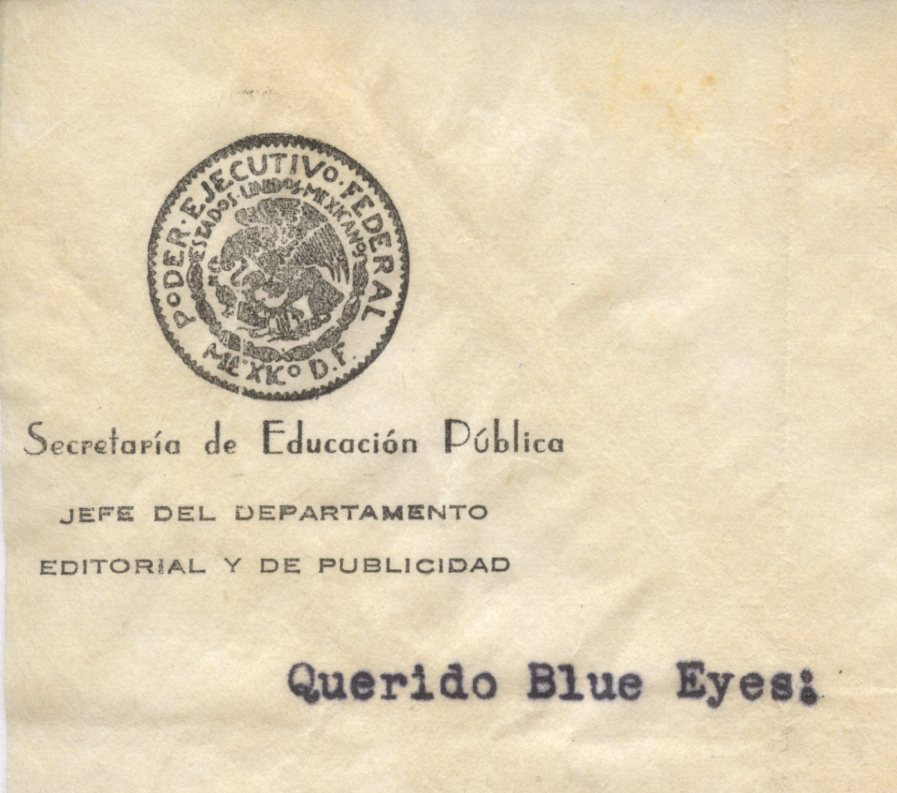
In 1941 when Henry Schnautz meets Esperanza for the first time, she is working for the Secretary of Public Education, SEP, under new president Manuel Avila Camacho.
In 1941 Henry wrote -"During the last 5 yrs she has worked in the Education Dept." That would place her at the Dept of Education from 1936 to at least the beginning of 1944 (when she is still typing letters on department letterhead to Henry). She is working in the Publications Department which included student textbooks. During the Cardenas years the ministry was a center for the leftist programs with Toledano a strong influence, but it began moving to the right after the 1940 election. The minister in 1941 is Octavio Vejar Vazquez. In 1942 he was involved in a fight to eliminate marxist ideology from Mexican schoolbooks. He eventually resigned December 1943 over differences with Lombardo Toledano.
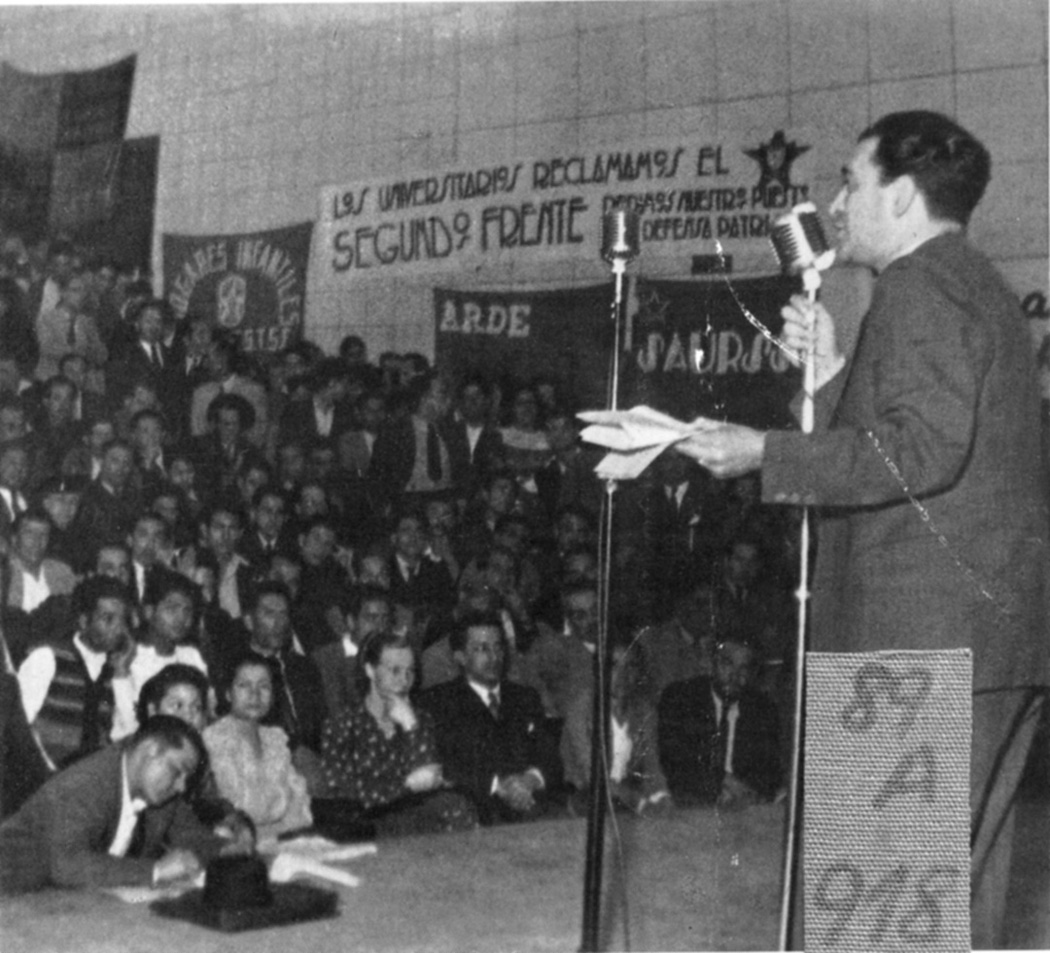
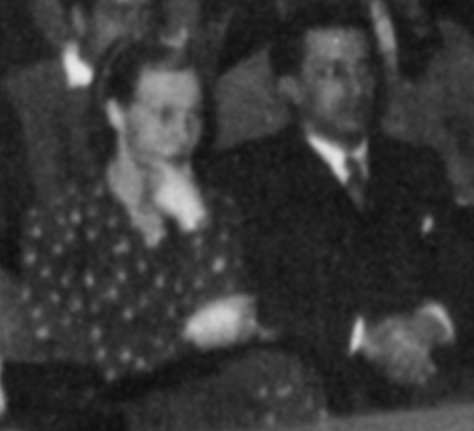
I bought a used copy of "Brucken nach Mexiko", Wolfgang Kiessling, Dietz Verlag, 1989.
The dust jacket has a photo of a speech by Vicente Lombardo Toledano, the Mexican politician and marxist who had a professional relationship with Esperanza Lopez Mateos from 1938 or earlier until her death. In the front row is a woman who resembles Esperanza. Unfortunately its a half-tone reproduction, so there is not much detail. Its a great photo showing the crowd standing on the stairs.
The caption reads - Vicente Lombardo Toledano spricht bei der Veranstaltung zur Eroffnung der 2. Front (1942)
Vicente Lombardo Toledano speaks at the event to open the 2nd Front (1942)
Stalin had repeatedly asked Roosevelt and Churchill to open up a second front in France or elsewhere in Europe to avoid facing all of Hitler's army. This of course was not accomplished until D-Day 6 June 1944 and after the Battle of Stalingrad between August 1942 to February 1943.
Mexico entered the war with Germany in May 1942.
For comparison, an earlier studio photo of Esperanza and a photo Henry Schautz took on vacation in 1946
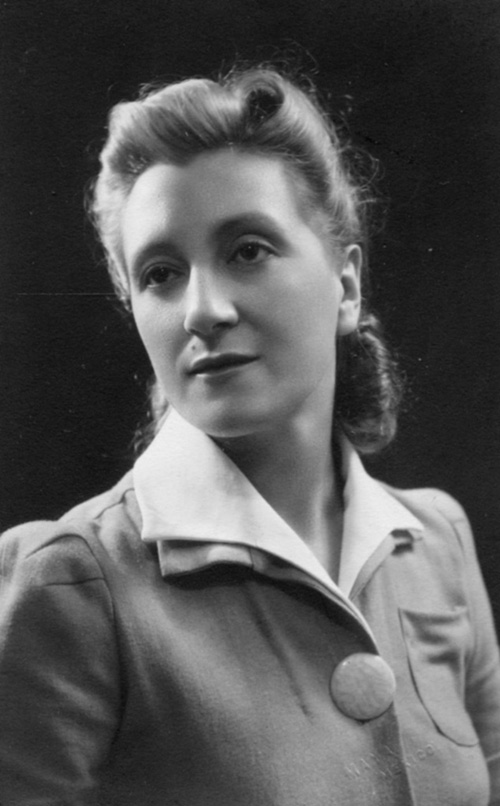
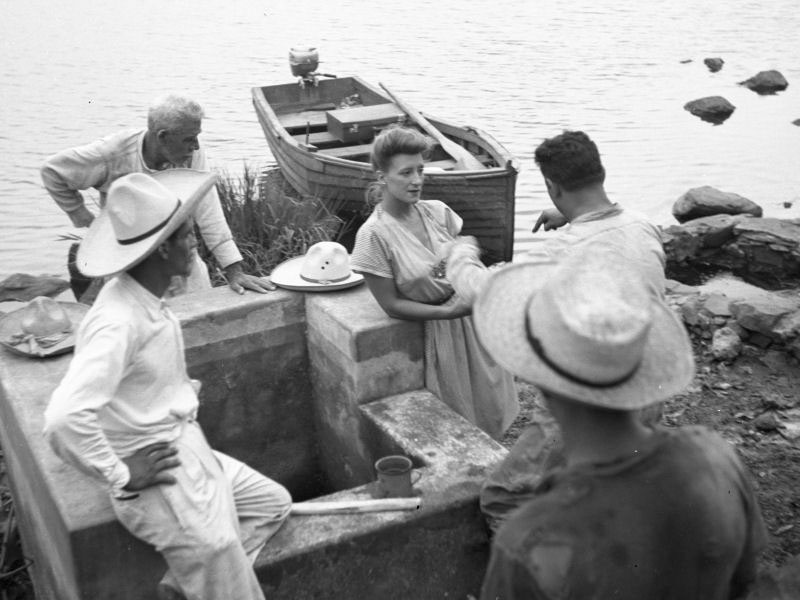
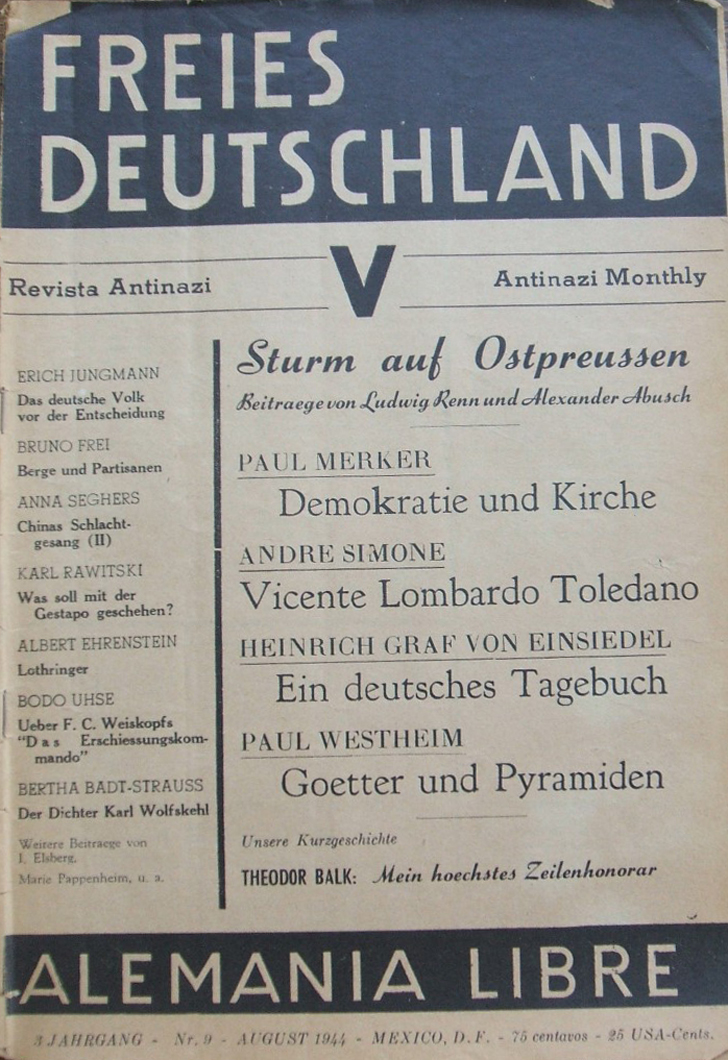
A new wave of German communist emigres arrived in Mexico City starting in 1940 when France fell to the Nazis. These included famous writers such as Anna Seghers, Egon Erwin Kisch, Ludwig Renn, and many others who had been forced out of Germany and Europe. Lombardo Toledano, "el jefe marxista mexicana," welcomed them with open arms. Just as he helped the Liga Pro Cultura Alemana, he helped them continue their writing and political careers.
Freies Deutschland was their Antinazi Monthly magazine, published in German in Mexico City, with well known German writers.
El Libro Libre was their book publishing operation.
The Heinrich Heine Klub was their social club that organized talks and theater plays. Heinrich Heine was a 19th century German writer. His books were among those burned by the nazis, engraved on a memorial in Germany is his quote, "Where they burn books, they will ultimately burn people as well." The nazi book burning in 1933 of unapproved authors was the beginning signal for German intellectuals to leave Germany for destinations all over the world.
As Lombardo did for Liga Pro Cultura Alemana, he lends his name and credibility to the organization.
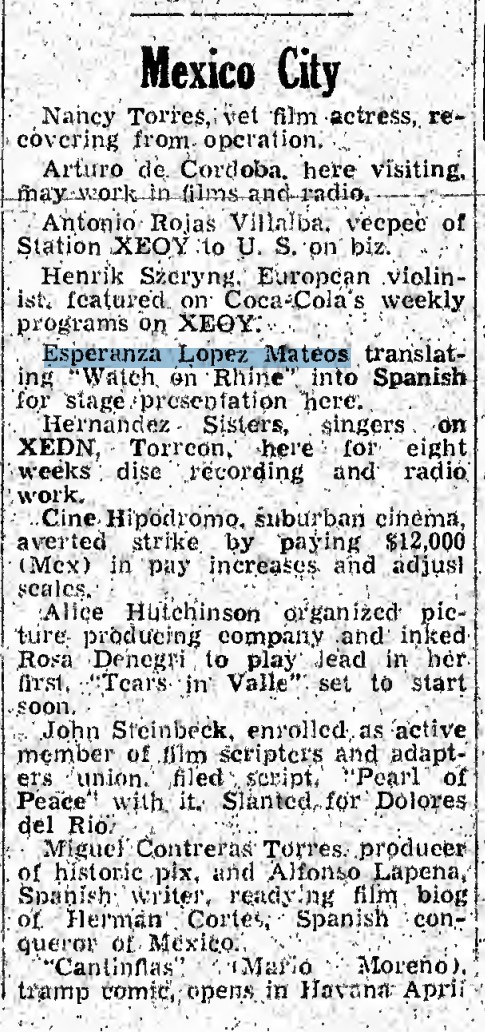
One of the star emigres who worked closely with Toledano from his arrival in Mexico in 1940-41 was a Czech national named Otto Katz, who wrote for Freies Deutschland under name Andre Simone. Katz was one of the most successful Soviet agents of the 20th century. He had a hollywood period under the alias Rudolf Breda where he formed anti-Nazi associations and was the inspiration for the anti-nazi freedom fighter in the 1944 Academy Award movie, "Watch on the Rhine." by author Lillian Hellman.
From "Variety" March 1944, a magazine of the American film industry, appears a notice that Esperanza Lopez Mateos is translating the script "Watch on Rhine" into Spanish for a stage play. This is during the height of Katz's influence in Mexico City and possibly connected with the stage productions of the Heinrich Heine club.
The story of Katz is nearly the story of the first half of the 20th century, as he was involved wherever his propaganda talents were most needed. An excellent book is
"The Dangerous Otto Katz," Jonathan Miles, Bloomsbury, 2010
Vicente Lombardo Toledano was a Stalinist-Marxist in the mid 30s to the end of the war at least. The evidence for that is extensive. An excellent essay dealing with Lombardo's all-in involvement with the famous German communist emigres of 1940 onward is
Heidi Zogbaum (2005) Vicente Lombardo Toledano and the German communist exile in Mexico, 1940-1947, Journal of Iberian and Latin American Research
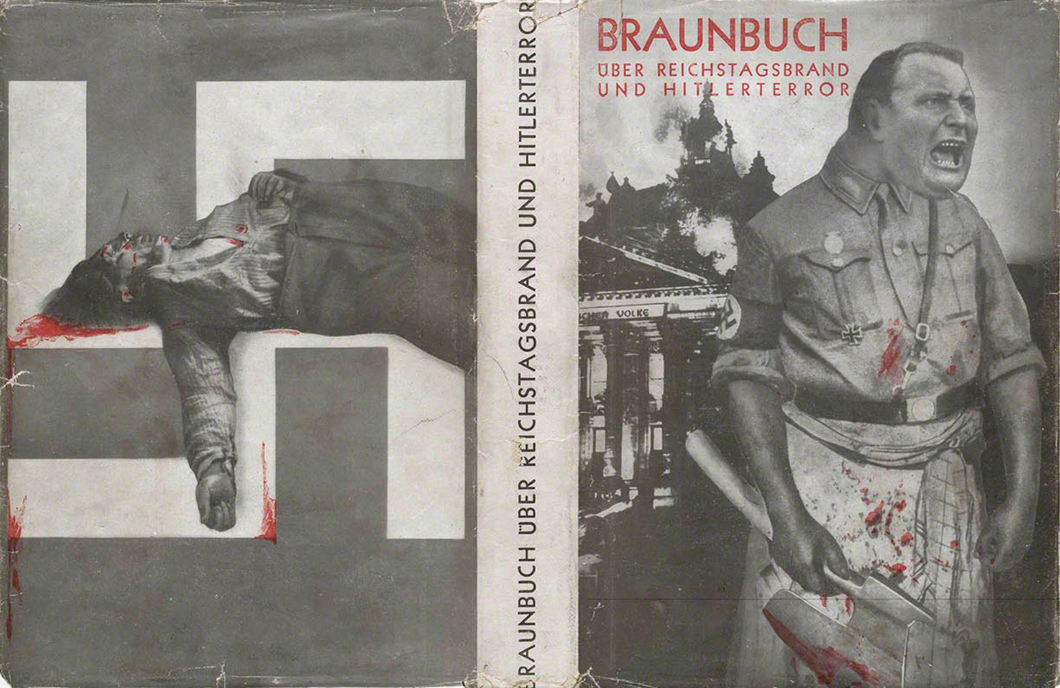
Hitler and the Nazi party never won a popular election. They took control over a period of years. One of the final blows towards dictatorship was the Reichstag fire in 1933. Hitler used it to suspend individual rights and the guarantees of the German constitution. These did not return until after the war.
Prior to the trial to determine the guilt of the arsonists, Otto Katz and Willi Munzenberg, "the Red millionaire", published in France "The Brown Book of the Reichstag Fire and Hitler Terror," to major success. The book charged that Hermann Göring, who was the Reichstag president, set the fire using an underground utility tunnel from his official residence. Others took the blame, convenient enemies. An exodus of emigres out of Germany first to other countries in Europe and later to places all over the world accelerated sharply.
wiki The_Brown_Book_of_the_Reichstag_Fire
PDF The Brown Book of the Hitler Terror and the Burning of the Reichstag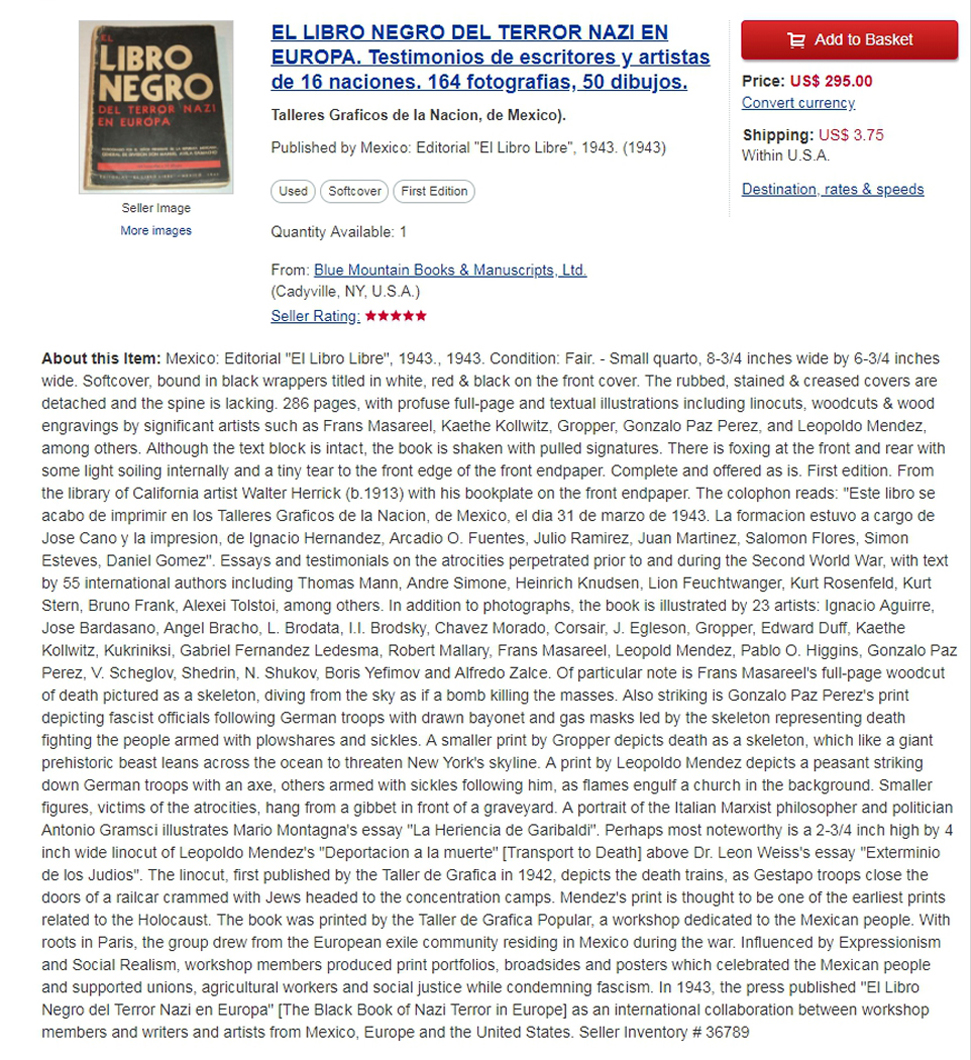 PDF El Libro Negro del Terror Nazi en Europa
PDF El Libro Negro del Terror Nazi en Europa
In Mexico, Katz, using the alias Andre Simone, repeated his success with the Black Book in 1943. Published by El Libro Libre, the publishing house was Talleres Graficos de la Nacion.